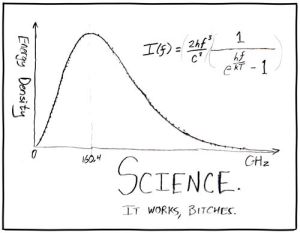In today’s post I was going to announce the winners of my Unparadox Contest. But then I noticed the Lake Wobegon unparadox: if the total winnings are zero, then no one’s winnings are below average and in that sense, everyone’s a winner!
So instead of that, I thought I’d contribute to the general shnoodification of humankind, by discussing the same thing every other science blogger’s discussing: Paul Davies’s New York Times op-ed.
Over the years I have often asked my physicist colleagues why the laws of physics are what they are. The answers vary from “that’s not a scientific question” to “nobody knows.” The favorite reply is, “There is no reason they are what they are — they just are.” The idea that the laws exist reasonlessly is deeply anti-rational. After all, the very essence of a scientific explanation of some phenomenon is that the world is ordered logically and that there are reasons things are as they are. If one traces these reasons all the way down to the bedrock of reality — the laws of physics — only to find that reason then deserts us, it makes a mockery of science.
Now, I know Paul Davies: he took me out to a nice dinner in Iceland, and even quoted me next to Ludwig Wittgenstein in the epigraph of one of his papers. And I know for a fact that his views are much more nuanced than you’d think, if the above passage was all you were going on. I can assure you that, if his claim that physics without metaphysics is “a mockery of science” reminds you of those hooded monks from Monty Python and the Holy Grail, pounding their heads with wooden boards in between mystic incantations, then you’ve read his piece too superficially and have failed to grasp its subtler message.
But even so, reading his op-ed made me wonder: when did we, as a civilization, have a similar conversation before? Then I remembered: the early 1600’s!
Galileo: Hey, I’ve discovered that Jupiter has moons! And that objects in free fall follow parabolic trajectories! And that…
Jesuit schoolmen: Ah, foolish one, but you have told us nothing about the underlying causes of motion, or what it is that imbues the lunar bodies with their lunarity. Of what use are your so-called “explanations” if they rest on a foundation that is itself unexplained? One can hardly build a pyramid on sand!
One imagines the schoolmen feeling sorry for the naïve Galileo, with his rampant scientism and countless unexamined presuppositions. In their minds, if Galileo hadn’t explained everything then he hadn’t really explained anything — and hence they themselves (who had explained nothing) were the wiser by far.
Four hundred years after the scientific revolution, most people still think like the Jesuit schoolmen did:
How does a toaster work?
By converting electrical energy into heat.
But what is electricity?
The movement of electrons through a wire.
But what are electrons?
Fundamental particles with spin 1/2, negative charge, mass of 10-27 grams…
But why do particles exist? Why does anything exist?
Well, those are excellent and profound questions, and you see…
Aha! Aha! So science doesn’t have all the answers! Ultimately, then, science is just another form of faith!
The schoolman glances at the intermediate steps — how a toaster works, what electricity is, what electrons are — and is not only profoundly unimpressed, but baffled and annoyed that anyone thinks he should be impressed. What are these so-called “answers” but irrelevant distractions from the Answer? What are they but the build-up to the punchline, stepping-stones on the road to the metaphysical abyss?
Science, in the schoolman’s mind, is just a massive con game: an attempt to distract people from the ultimate questions of essence by petty conjuring tricks like curing diseases or discovering the constituents of matter. Even pure math is part of the con: all Wiles did was reduce Fermat’s Last Theorem to some supposedly “self-evident” axioms. But why bother with such a reduction, if you can’t justify the axioms or the laws of logic themselves?
I frequently encounter the schoolmen even in my little corner of the world. People will ask: isn’t computational complexity theory a colossal failure, since all you ever do is prove “this problem is as hard as that other one,” or “this problem is hard relative to an oracle,” and never really prove anything is hard?
Let’s leave aside the factual misunderstandings — we can prove certain problems are hard, etc. etc. — and concentrate on the subtext, which is:
Don’t waste my time with the accumulated insights of the last half-century. If you haven’t solved the P versus NP problem — and you haven’t, right? — then aren’t you, ultimately, just as ignorant about computation as I am?
Of course, “does P=NP?” differs from “where do the laws of physics come from?” in that we know, at least philosophically, what an answer to the former question would look like. And yet, if complexity theorists ever do prove P≠NP, I’m guessing the schoolmen will switch immediately to saying that that was merely a technical result, and that it doesn’t even touch the real question, which is something else entirely.
The schoolmen’s philosophy leads directly to a fatalist methodology. What causes polio? If you say a virus, then you also have to explain what viruses are, and why they exist, and why the universe is such that viruses exist, and even why the universe itself exists. And if you can’t answer all of these questions, then your so-called “knowledge” rests on a foundation of arbitrariness and caprice, and you’re no better off than when you started. So you might as well say that polio is caused by demons.
Yet so long as the schoolmen are careful — and define the “ultimate explanation for X” in such a way that no actual discovery about X will ever count — their position is at least logically consistent. I’ll even confess to a certain sympathy with it. I’ll even speculate that most scientists have a smidgen of schoolman inside.
All I really object to, then, is the notion that tracing every question down to what Davies calls “the bedrock of reality” represents a new, exciting approach to gathering knowledge — one at the cutting edge of physics and cosmology. Say whatever else you want about the schoolman’s way, it’s neither new nor untried. For most of human history, it’s the only approach that was tried.
 Follow
Follow

